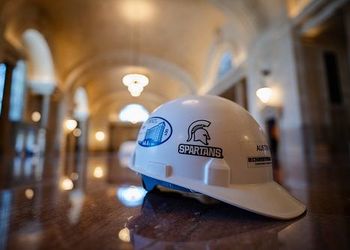Stephanie Crockatt: A Passion for Parks

With the blood of her golf-loving Scottish grandfather coursing through her veins, Stephanie Crockatt is combining her lifelong passion for golf, her Michigan State education in landscape architecture and park and recreation resources, and her real-world experience in nonprofit management and fundraising to drive her career.
She lives and works in Buffalo, New York, as executive director of the Buffalo Olmsted Parks Conservancy, a nonprofit community organization.
The city’s park system was designed by Frederick Law Olmsted (1822-1903), who is considered the father of American landscape architecture. His most notable individual design is New York City’s Central Park.
When he was invited to Buffalo in the late 1860s, Olmsted was moved by the bustling metropolis’ radial footprint to propose not one park, but a whole system of parks and parkways. The seven parks also encompass three public golf courses.
From her cozy office in a rustic lodge in historic Delaware Park, Crockatt calls her job the “pinnacle convergence” of her life, post-education.
The conservancy is dedicated to stewarding Olmsted’s vision for Buffalo—one of the nation’s first urban park systems. Crockatt takes that responsibility seriously, though, as the former president and executive director of the LPGA Tournament Owners Association, she still loves a good golf meeting.
“Parks are an urban environment’s living infrastructure,” she says. “More people in the world now live in urban (versus rural) settings. In many American metros, millennials are moving into city space; people are adaptively reusing downtowns. Greenspace becomes their backyards. They need recreation, clean air, playgrounds, the chance to ‘get away.’ Olmsted’s vision was actually that parks should be for resting.”
The conservancy and the Buffalo region will celebrate the parks’ 150th anniversary in 2018.
“One of our biggest challenges, and our goal, is to increase awareness of what a conservancy is,” Crockatt says. “People think that ‘public parks’ are paid for with their tax dollars; many don’t realize that the conservancy—through private donations—covers 60 percent of the Olmsted Parks’ budget. New York City’s Central Park operates on the same model.
“In addition to maintaining these historic parks, we advocate for and protect them—work to show their benefits. The property values around Delaware Park (the most centrally located of Buffalo’s Olmsted parks) are higher because they are on an Olmsted park,” she says.
“In 2018, all eyes will be on Buffalo,” Crockatt said. “If what we do is successful, it creates opportunity for alignment between other municipalities and nonprofits.”
In Buffalo, once again bustling with investment dollars and expansion, and where many major cultural institutions are in or adjacent to an Olmsted park, her job has a distinctly political bent.
“There are so many agendas,” she says. “Many value parkland; others see it as ripe for development. The question is, how do we protect the integrity of the historic landscape and accommodate change and progress?”



